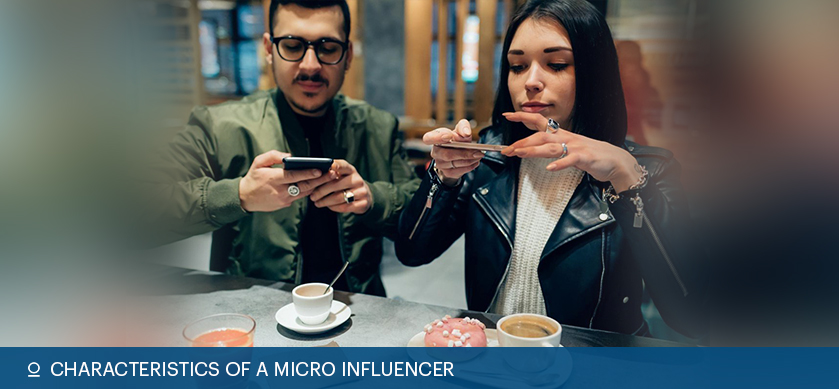As the validity of word of mouth advertising has continued to prove successful, the rise of influencer marketing campaigns and their respective budgets has come with it. If you’re a marketer with a lean allowance or even an enterprise organization just getting started with influencer marketing, you will likely focus your efforts on targeting micro influencers versus celebrities with household names. In this post we’ll explore the key characteristics of micro influencers.
The key difference between macro and micro influencers is primarily their level of name recognition across mass audiences. Micro influencers typically have smaller, more focused audiences around a singular topic. This is in comparison to celebrities or macro influencers who have gained popularity as entertainers and tend to appeal to the masses.
So, can anyone with an Instagram account be a micro influencer? The short answer is no. To be an influencer you need to have an ability to shape behavior and perceptions. The influencer’s ability to have this impact is typically based on their individual expertise, popularity, or reputation within a target market.
Size of following
Marketing standards have determined that micro influencers have an online following ranging from 1,000-100,000 followers. They can attract this following on one particular platform, such as Instagram, or can spread out their following across multiple channels including a blog or email list. This can make the exact following of an micro influencer more difficult to calculate as the top influencers have their fans follow them on more than one platform. Generally though, a minimum of 1,000 followers is expected when partnering with micro influencers.
High engagement rate
With micro influencers, less is more. Although they have a smaller following, they tend to have higher engagement rates with their audience, creating a better measure of influence. Although their audience is still growing, they have a two-way relationship that creates a loyal audience who values what they have to say. Micro influencers have created a level of trust with their community that celebrities simply don’t have, building their network post-by-post. According to AdWeek, “Engagement rates driven by micro-influencers are 60% higher and those campaigns are 6.7 times more efficient per engagement than influencers with larger followings”.
Focused content
Unlike macro-influencers who appeal to diverse audiences for various reasons, micro influencers tend to position themselves as an authority on a particular topic. For example, fashion influencers can be found on Instagram sharing DIY photoshoot content sporting their favourite brands, and many YouTube influencers have built a library of videos reviewing the latest tech products or sharing free fitness routines.
Audiences are drawn to micro influencers for a particular type of content that they share and therefore their posts are more predictable.
Relatability
Micro influencers are characterized as relatable, genuine and trustworthy. While most people use social media platforms as a form of entertainment or to connect with their friends, micro influencers view these outlets as channels to share their voice. Audiences are drawn to the point of view they have on the world and because micro influencers are comfortable being vulnerable and sharing an authentic voice, they’ve built audiences of people who empathize with their stories and associated social content.
Micro influencers value their followers and are readily available to engage with their community through attending events, replying to comments, and having a presence both online and offline. This level of interaction humanizes them and makes them feel like more of a friend than a media personality.
Loyalty
As micro influencers continue to grow their audiences organically, they tend to have a lot of people following them that they’ve already met or who have been watching their content from the beginning. Their audiences have been invited into their personal lives and have watched the impact of their growing influence. As micro influencers continue to let their followers in on intimate aspects of their everyday experiences, they’ve drawn loyal audiences who are keen to watch the next video and share their latest blog post.
Since the followers are generally loyal to influencers, they trust and value their opinion because they see them as “gurus” in that particular niche. A recent study by Experticity reveals that 82% of consumers are highly likely to follow a recommendation made by a micro influencer.
Affordability
Micro influencers are usually more affordable than their macro counterparts- high profile celebrities or accounts with millions of followers. Approximately 97% of micro-influencers on Instagram charge less than $500 for a promotion post, compared to a fee that could get into the six figures range for famous celebrities. Some micro influencers will also accept free products or early access to unreleased products. Not only are micro influencers affordable, but in the end brands are actually getting more value for their money and are seeing overall higher ROI.
For example, you could pay $10,000 for one post from a macro influencer, or you could invest the same into a campaign with 20 micro-influencers to reach a more targeted and engaged audience!
Characteristics of micro influencers vary across many different industries and niches but these 6 key characteristics are what makes micro influencers stand out amongst the rest. They’re thought leaders on topics that genuinely interest them and have gained their audience by consistently following their passions, sharing quality and valuable content, and allowing their audience in on the journey.

